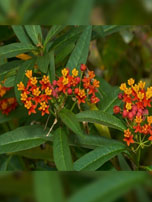SHAHEED
KARTAR
SINGH
SARABHA
A Y U R V E D I C M E D I C A L C O L L E G E & H O S P I T A L
Affiliated to Guru Ravidas Ayurved University, Hoshiarpur Punjab
Affiliated to Guru Ravidas Ayurved University, Hoshiarpur Punjab

Botanical Name : Asclepias curassavica
Family :
Apocynaceae
Names in different Indian languages :
English : Scarlet Milkweed, Bloodflower, Silkweed, Indian root
Hindi : Kakanasa, Kakatundi
Manipuri : Krishnachura
Marathi : Pivla chitrak, Halad kunku
Synonyms :
Asclepias bicolor,
Asclepias aurantiaca,
Asclepias cubensis
Morphology :
Scarlet milkweed is an erect, evergreen perennial subshrub, often grown as an annual. Like most milkweeds, it has opposite leaves and milky sap. The blossoms of scarlet milkweed are are red and orange, less than an inch across, and appear in clusters at the top of 2 to 4 ft. stalks. It is without a doubt the best milkweed species for the home garden. Scarlet milkweed gets about 3-4 ft tall and usually has a few pairs of symmetrical branches. The leaves are about 5 in long, narrowly elliptic, and pointed at both ends. It blooms continuously from spring until autumn. The fruits are spindle shaped pods, 3-4 in long, that eventually split open to release little flat seeds that drift away on silky parachutes. Scarlet milkweed is native to South America but has become a naturalized weed in tropical and subtropical pastures, fields and disturbed areas throughout the world.
Medicinal uses :
1. The latex of the plant as well as the roots, leaves, and flowers are used medicinally
2. The root is febrifuge. A decoction is used in the treatment of dysentery and as an eyewash for infected eye.
3. The root contains a glycoside, asclepiadin, which is used as an emetic and purgative.
4. It has been used as a substitute for ipecacuanha
5. A paste made of the crushed leaves, combined with salt, vegetable oil and bread, is used for treating skin ulcers
6. The plant contains an abundant white latex which is applied to warts and corns in order to kill them
7. The juice of the whole plant is used to treat ringworm, sores, rashes, dermatitis etc.
8. The plant is considered cicatrizant (healing cuts etc by encouraging the formation of scars)
9. The aerial parts of plant are sometimes used in the treatment of dysentery and as an eyewash for infected eyes
10. The root contains cardenolides with aglycones such as asclepogenine and curassavogenine.
11. The latex contains cardenolides and esterified triterpenes. Extracts stimulate the central nervous system.
12. The latex also contains quercetin, caffeic acid, sterols, flavonoids, carbohydrates, fatty acids and acidic mucilage.
13. The plant contains beta-sitosterol, which is antihypercholesterolemic (reduces cholesterol), anti-prostatic, and oestrogenic
Other Uses :
1. The stem fibres are used for spinning, partly in mixture with cotton.
2. The seed hairs are used as a stuffing material for pillows.
3. This is too elastic for spinning unless altered by chemical treatment after which it can be spun admixed with cotton.
4. The stems are used, tied in bundles, as brooms.
Propagation Seed : surface sow and make sure the seeds are kept moist